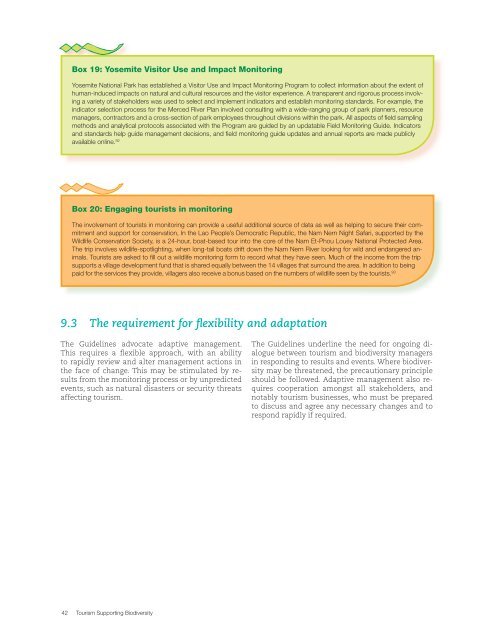1Tgjonb
1Tgjonb
1Tgjonb
You also want an ePaper? Increase the reach of your titles
YUMPU automatically turns print PDFs into web optimized ePapers that Google loves.
Box 19: Yosemite Visitor Use and Impact MonitoringYosemite National Park has established a Visitor Use and Impact Monitoring Program to collect information about the extent ofhuman-induced impacts on natural and cultural resources and the visitor experience. A transparent and rigorous process involvinga variety of stakeholders was used to select and implement indicators and establish monitoring standards. For example, theindicator selection process for the Merced River Plan involved consulting with a wide-ranging group of park planners, resourcemanagers, contractors and a cross-section of park employees throughout divisions within the park. All aspects of field samplingmethods and analytical protocols associated with the Program are guided by an updatable Field Monitoring Guide. Indicatorsand standards help guide management decisions, and field monitoring guide updates and annual reports are made publiclyavailable online. 92Box 20: Engaging tourists in monitoringThe involvement of tourists in monitoring can provide a useful additional source of data as well as helping to secure their commitmentand support for conservation, In the Lao People’s Democratic Republic, the Nam Nern Night Safari, supported by theWildlife Conservation Society, is a 24-hour, boat-based tour into the core of the Nam Et-Phou Louey National Protected Area.The trip involves wildlife-spotlighting, when long-tail boats drift down the Nam Nern River looking for wild and endangered animals.Tourists are asked to fill out a wildlife monitoring form to record what they have seen. Much of the income from the tripsupports a village development fund that is shared equally between the 14 villages that surround the area. In addition to beingpaid for the services they provide, villagers also receive a bonus based on the numbers of wildlife seen by the tourists. 939.3 The requirement for flexibility and adaptationThe Guidelines advocate adaptive management.This requires a flexible approach, with an abilityto rapidly review and alter management actions inthe face of change. This may be stimulated by resultsfrom the monitoring process or by unpredictedevents, such as natural disasters or security threatsaffecting tourism.The Guidelines underline the need for ongoing dialoguebetween tourism and biodiversity managersin responding to results and events. Where biodiversitymay be threatened, the precautionary principleshould be followed. Adaptive management also requirescooperation amongst all stakeholders, andnotably tourism businesses, who must be preparedto discuss and agree any necessary changes and torespond rapidly if required.42 Tourism Supporting Biodiversity


